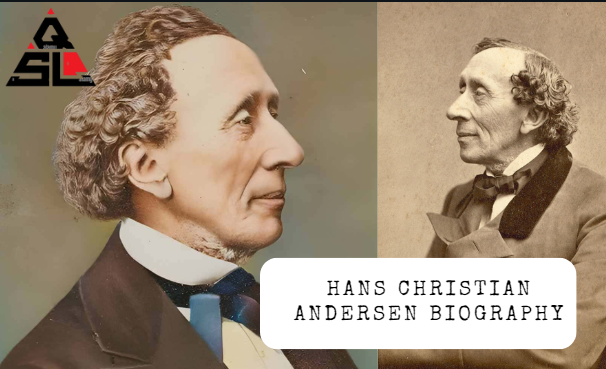
Hans Christian Andersen Biography – Hans Christian Andersen is a name synonymous with fairy tales that have enchanted both children and adults for generations. His rich storytelling has transcended time, making him one of the most celebrated authors in literary history.
Hans Christian Andersen Biography
| Name | Hans Christian Andersen |
|---|---|
| Born | April 2, 1805, Odense, Denmark |
| Died | August 4, 1875, Copenhagen, Denmark |
| Occupation | Author, Playwright, Poet |
| Notable Works | “The Little Mermaid,” “The Ugly Duckling,” “The Snow Queen” |
| Net Worth | $500,000 |
| Age at Death | 70 years |
| Cause of Death | Liver Cancer |
| Spouse | Not Disclosed |
Early Life and Background
Who is Hans Christian Andersen?
Hans Christian Andersen was born on April 2, 1805, in Odense, Denmark. Despite a modest beginning, his literary genius has left an indelible mark on the world. Andersen’s father, also named Hans, instilled in him a love for literature by reading stories like Arabian Nights. His mother, Anne Marie Andersdatter, was an illiterate washerwoman who struggled to make ends meet after her husband’s death in 1816.
Family and Upbringing
Andersen’s family background was humble. His father considered himself related to nobility, though these claims were never substantiated. Some even speculated that Andersen was the illegitimate son of King Christian VIII, a theory supported by Danish historian Jens Jørgensen. Despite these rumors, Andersen’s life was shaped by his immediate family’s hardships and his early education.
Education and Early Struggles
After his father’s death, Andersen’s mother remarried, and he attended a local school for poor children. Here, he received basic education while working as an apprentice to a weaver and later to a tailor. At 14, he moved to Copenhagen to pursue a career in acting, which led him to the Royal Danish Theatre. His soprano voice won him a spot, but when his voice changed, he pivoted to writing.
Literary Beginnings
Jonas Collin, director of the Royal Danish Theatre, recognized Andersen’s potential and facilitated his education, even convincing King Frederick VI to sponsor it. Andersen published his first story, “The Ghost at Palnatoke’s Grave,” in 1822. His schooling years were challenging, marked by abuse and discouragement from writing, leading to a period of depression.
Rise to Fame
Breakthrough and Notable Works
Despite the hardships, Andersen’s talent blossomed. His fairy tales, consisting of 156 stories across nine volumes, have been translated into more than 125 languages. These stories have become embedded in Western culture, appealing to both children and adults. His most famous tales include:
- “The Emperor’s New Clothes”
- “The Little Mermaid”
- “The Nightingale”
- “The Steadfast Tin Soldier”
- “The Red Shoes”
- “The Princess and the Pea”
- “The Snow Queen”
- “The Ugly Duckling”
- “The Little Match Girl”
- “Thumbelina”
Impact and Legacy
Andersen’s stories have inspired countless adaptations in the form of ballets, plays, and films. His works teach lessons of virtue and resilience, making them timeless pieces of literature. His influence extends beyond storytelling, shaping various art forms and inspiring future generations of writers and artists.
Hans Christian Andersen Wife and Relationships
Details about Andersen’s personal relationships, including whether he had a wife, remain largely undisclosed. Despite his fame, Andersen was known to be private about his personal life.
Speculations and Controversies
There were speculations about Andersen’s sexuality, with some suggesting he was gay. However, these claims lack substantial evidence, and Andersen himself did not publicly address these rumors.
Later Years and Death
In his later years, Andersen continued to write and travel. His health began to decline, and he was diagnosed with liver cancer. Despite his illness, he remained active and engaged with his literary work.
Hans Christian Andersen Cause of Death
Hans Christian Andersen passed away on August 4, 1875, at the age of 70. His cause of death was liver cancer. He was buried in the Assistens Cemetery in Copenhagen, leaving behind a legacy of timeless fairy tales.
Hans Christian Andersen Net Worth and Financial Status
At the time of his death, Hans Christian Andersen’s net worth was estimated to be around $500,000. While not extravagant, this amount reflects the success and widespread popularity of his works.
Influence and Cultural Impact
Global Reach
Andersen’s fairy tales have reached a global audience, with translations in over 125 languages. His stories are a staple in children’s literature, and their themes resonate with readers of all ages.
Inspiration for Other Works
His tales have inspired numerous adaptations, including Disney’s animated films like “The Little Mermaid” and “Frozen,” which is loosely based on “The Snow Queen.” Ballets, plays, and other artistic expressions continue to draw from Andersen’s rich storytelling.
Conclusion
Hans Christian Andersen’s life was marked by resilience and creativity. From a humble beginning in Odense to becoming a celebrated author, his journey is a testament to the power of storytelling. His fairy tales continue to enchant and inspire, ensuring his legacy endures for generations to come.
FAQs
1. Was Hans Christian Andersen married?
Andersen’s personal relationships remain largely undisclosed, and there is no definitive record of him being married.
2. How did Hans Christian Andersen die?
Hans Christian Andersen died of liver cancer on August 4, 1875.
3. What is Hans Christian Andersen’s net worth?
At the time of his death, his net worth was estimated to be around $500,000.
4. What are some of Hans Christian Andersen’s most famous works?
Some of his most famous works include “The Little Mermaid,” “The Ugly Duckling,” “The Snow Queen,” and “The Emperor’s New Clothes.”
5. Where was Hans Christian Andersen born?
Hans Christian Andersen was born in Odense, Denmark, on April 2, 1805





